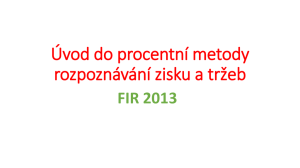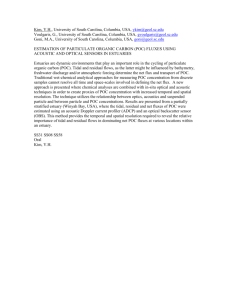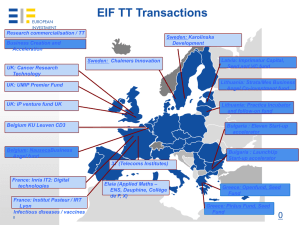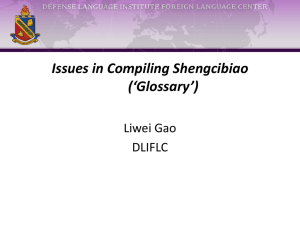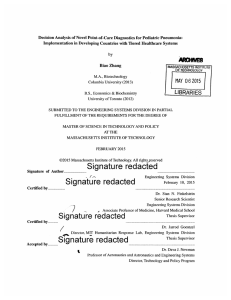Interview guide POC BMGF The aim of the key
advertisement
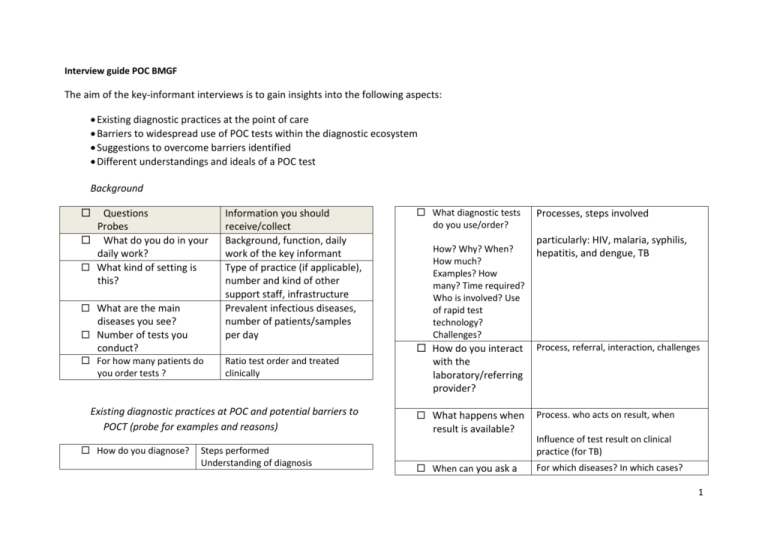
Interview guide POC BMGF The aim of the key-informant interviews is to gain insights into the following aspects: Existing diagnostic practices at the point of care Barriers to widespread use of POC tests within the diagnostic ecosystem Suggestions to overcome barriers identified Different understandings and ideals of a POC test Background Questions Probes What do you do in your daily work? What kind of setting is this? What are the main diseases you see? Number of tests you Information you should receive/collect Background, function, daily work of the key informant Type of practice (if applicable), number and kind of other support staff, infrastructure Prevalent infectious diseases, number of patients/samples per day conduct? For how many patients do you order tests ? Ratio test order and treated clinically Existing diagnostic practices at POC and potential barriers to POCT (probe for examples and reasons) How do you diagnose? Steps performed Understanding of diagnosis What diagnostic tests do you use/order? How? Why? When? How much? Examples? How many? Time required? Who is involved? Use of rapid test technology? Challenges? Processes, steps involved particularly: HIV, malaria, syphilis, hepatitis, and dengue, TB How do you interact with the laboratory/referring provider? Process, referral, interaction, challenges What happens when Process. who acts on result, when result is available? When can you ask a Influence of test result on clinical practice (for TB) For which diseases? In which cases? 1 test and can make treatment decision on the spot (while the patient waits)? How are CHWs involved? What are the costs involved? Examples, Barriers their tasks related to testing & treatment, use of tests, potential for diagnostic testing For instance: for each test, kick-backs, user charges, reimbursement, willingness to pay clinician How? How do you assure quality? Understanding of quality (what is it? what matters?) Mechanisms, processes, challenges How do you record data? On patients & test results Processes, notifications Actors involved How are patients informed /counseled? Understanding, processes, actors involved, challenges in interacting with patients Have you changed the diagnostic set-up at one point? Processes Challenges Actors involved What are your main Unmet needs challenges in diagnosing? How do you deal with the challenge? What is a good diagnosis? You can also probe for challenges mentioned by other actors/ in FGDs Understanding of ideal Situation, view on diagnosing Different understandings and ideals of a POC test Imagine a test that would allow a treatment decision within one clinical encounter How long would patient wait? What would be criteria of an ideal TB test? What would you suggest to test developers? understand reasons for answers What test would you conduct here? What could be diagnosed at different levels? What could be barriers to POC testing of infectious diseases? THANK YOU Can you suggest someone else to talk to? Any additional comments Understanding of POC 2 Patient interview guide Who/what influenced you? What happened there? The aim of the patient interviews is to gain insights into the following aspects: treatment seeking behavior: reasons for seeking care, when, where, perceptions of quality, symptom identification and interpretation; interaction with health personnel; social support factors; and financial and structural barriers perceived needs of a POC test by patients Self-testing HIV & diabetes Questions Probes What is your occupation? Tell me how you came to know you had disease X (Tell me everything that happened before you started treatment) What were your symptoms? How long did you wait to seek care? Why? Where did you go first/last? Why? Information you should receive/collect Background, age, level of education, economic status Get the person talking, let the person tell their own story from his/her own perspective reasons for seeking diagnosis, potential for delays Reasons to seek service provider, understanding of what is a good doctor Who did you meet? How long did you wait? Was a test explained? What sample was taken? What happened next? When did you see a doctor? What did doctor do? Did you get a report? When? How was result communicated? Where did you wait? When was treatment initiated? How? What were the costs? Did you visit another provider? Why? How long did you wait? How long were you with this provider? What happened there? (see above) Minute details of the diagnostic process &treatment initiation Probe for the detailed steps or ask What happened next? sequence of providers visited reasons duration of medical care and time gap between successive providers Repeat this question till no more providers 3 Challenges? Why did you change providers? reasons for discontinuation of medical care/change of providers Were you not happy with it? What is a good doctor? Understanding of quality Would you test yourself with such tests? Why?/Why not? User feedback on dummy overall reactions, pro/con, comparison with current device, useability, feasibility How do you know? How long are you waiting for doctor, for lab result? How long are you able to wait/willing to wait? What is a good diagnostic test/process? What is important to you? Why do you think you have this disease? Did you tell your family? How did they react? How did your community react? Why? Have you ever tested yourself? Understanding of ideal test understanding of TB, cause of TB/illness responses of community, family, environment, perceived stigmatization How? Experiences? 4

